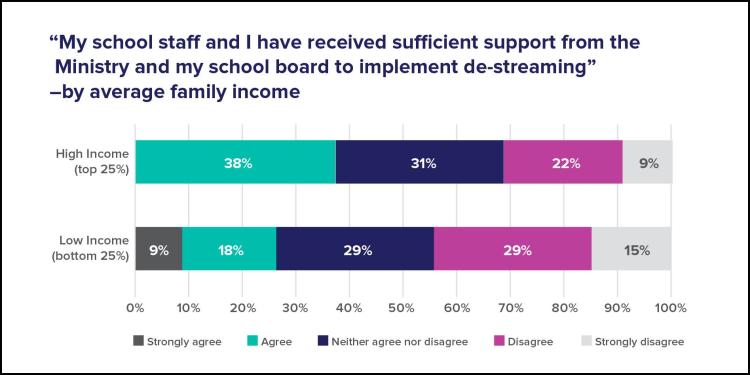People for Education's new report, Timing is everything: The implementation of de-streaming in Ontario's publicly funded schools,' reveals many gaps in the province's first steps toward de-streaming Grade 9. The report - based on findings from the 2021-22 Annual Ontario School Survey - makes recommendations for changes to support the full implementation of de-streaming in the fall of 2022.
Ontario introduced de-streaming after years of evidence showing that the policy systematically disadvantaged and marginalized Black students, Indigenous students, students with special education needs, and students from lower income families. These students were disproportionately placed in the Applied Stream with the result that they were less likely to gain all their credits in grade 9 and 10, less likely to graduate and less likely to go to either college or university.
Principals raise concerns about lack of supports
Timelines for implementing the math curriculum were near impossible for doing a good job at implementing the de-streamed math for this year. It was the worst roll-out of a curriculum change I have been involved with since I began in education in 1997.
Principal, Eastern Ontario
Only 30% of principals responding to the survey agreed with the statement, "My school staff and I have received sufficient support from the ministry and my school board to implement de-streaming." Even then, there were differences depending on the average income of the school neighbourhood - with 44% of principals in low-income neighbourhoods strongly disagreeing or disagreeing, compared to 31% of principals of schools in high-income neighbourhoods.
While the Ministry of Education provided some resources to support de-streaming, principals described multiple challenges in implementing this complex change, including the very short timelines, poor communications and a lack of sufficient support and direction from the Ministry - all of which were exacerbated by the strain of the ongoing pandemic.
"Few resources for curriculum delivery; plan rolled out with too much of a focus on rationale and too little on curriculum resources to support teachers and students in the classroom."
Secondary school principal, GTA
Piecemeal professional development / support for teachers
While 89% of principals reported that their school provided teachers with at least some training and professional development to support de-streaming, many of them raised concerns that the support was neither consistent nor effective.
The new de-steamed grade 9 mathematics curriculum was released in June 2021, giving educators only three months to prepare before the September implementation. As a result, much of the professional development and training was taking place while the teachers were already teaching the de-streamed course. In addition, the pandemic meant that teachers were constantly in a state of flux between in-person, online, and hybrid learning.
In August 2021, the Ministry of Education announced three mandatory professional development (PD) days, but de-streaming was only one of many topics to be covered. This meant there was little time for teachers to learn new methods or engage in discussions that lead to broader cultural shifts in beliefs, attitudes, and values - things that research shows are key for deep and sustainable change.
There have been far too many interruptions since the declaration of de-streaming. Many learnings have been cancelled, modified to accommodate to Zoom, etc. There is also a lack of universal expertise in getting effective professional learning in the context of real classroom learning. Theory is one thing: practice quite another.
Secondary school principal, GTA
Small class sizes for some, but not for all
Smaller class sizes for de-streamed courses were offered in 40% of schools overall, but there were differences depending on the average family income of the school neighbourhood.
Despite evidence that the benefits of reduced class sizes are greatest for students who are socially and economically disadvantaged, principals of schools in low-income neighbourhoods were much less likely than principals in high income neighbourhoods to report the availability of reduced class sizes for de-streamed courses (63% vs 38% respectively).
Limited support for families
The implementation of de-streaming presented a significant change, not only for education staff, but for students and their families as well. However, only 31% of principals reported that their schools had de-streaming supports and resources available for parent and guardians. Here too, inequities in access were evident. Nearly double (44%) the percentage of schools in high-income communities offered resources for parents and guardians compared to schools in low-income communities (24%).
Educational assistants and special education supports
While only 18% of principals reported an increase in the availability of supports such as educational assistants and special education supports, this was the one area that suggests more support was available in low-income neighbourhoods. Twenty-four percent of principals from schools in low-income areas reported that their schools offered increased learning supports, compared to sixteen percent of principals from schools located in high-income neighbourhoods.

People for Education's recommendations
People for Education has made three overall recommendations to ensure that more effective supports are in place to support the full de-streaming of grade 9 courses planned for September 2022.
- Plan in consultation with students, educators, education support staff, and families.
- People for Education continues to call on the province to convene an Education Task Force to provide advice on recovery and renewal post-pandemic, and on vital policy areas such as the implementation of de-streaming.
- Provide learning supports for de-streaming that meet schools' diverse needs.
- De-streaming is a significant structural, pedagogical, and cultural change for schools and school boards. To support the introduction of full de-streaming in grade 9 in September 2022, the province must provide sufficient and ongoing resources to support reduced class sizes, greater opportunities for professional development, accessible information for families, and additional staff.
- Monitor and evaluate implementation as frequently as possible.
- Simply de-streaming curriculum is not enough. The province must implement a comprehensive evaluation plan to ensure successful outcomes, in particular for the students who have been disproportionately disadvantaged by streaming in the past. The evaluation plan should be aligned with the new Board Improvement and Equity Plan, which mandates the collection of disaggregated demographic data to support school boards in tracking student achievement, equity, well-being, and transitions.













